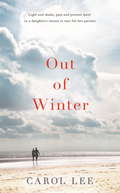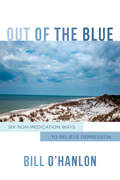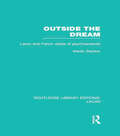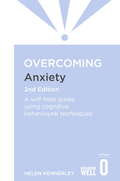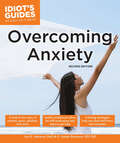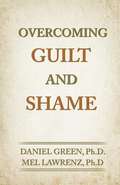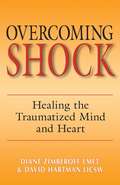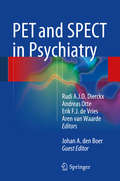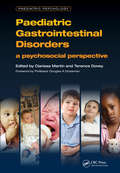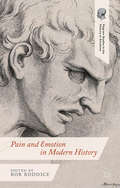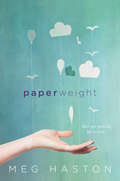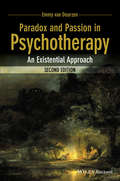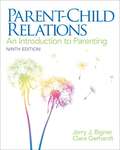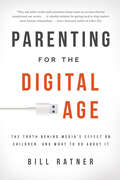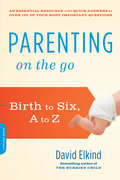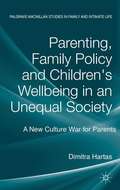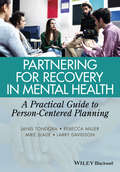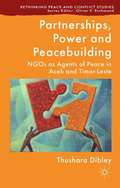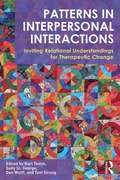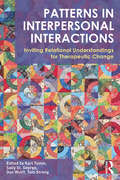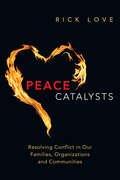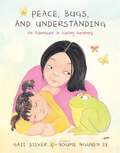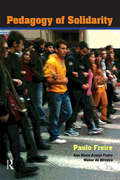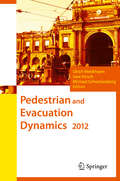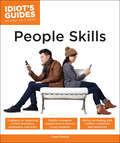- Table View
- List View
Out of Winter
by Carol LeeOUT OF WINTER is a personal account of how a father's sudden illness affects a family fraught by conflict over many years. It charts the process of grief which follows his death in 2008, and that of Carol Lee's mother only eight weeks later. Her mother's death, so swiftly after her father's, tests the limits of her ability to re-configure herself, to find who and what her mother and father are to her now, and to understand her brother's long flight into silence. In OUT OF WINTER, Carol Lee uncovers the history of people - her parents - whom, at the end, she comes to know and love. OUT OF WINTER confronts the idea of how well do we really know our parents?
Out of the Blue: Six Non-Medication Ways to Relieve Depression
by Bill O'HanlonAlternatives to standard drug treatments for this common problem. Depression is one of the most common issues that people bring to therapy. It is also a mental health condition with several well-known and readily available medications to treat it. That said, every clinician knows that medications do not work for all clients, and even if they do work they can often come with unwelcome side effects that are difficult and hard to bear. In short, medications are not foolproof. Fortunately today, with rising interest in non-drug approaches, effective and easy-to-implement alternative strategies exist for dealing with depression in your clients, either in conjunction with medication treatments or on their own. Six of the best are presented in this book. With his characteristic mix of insightful clinical anecdote and personal narrative, seasoned therapist Bill O'Hanlon lays out six of his go-to non-medication strategies for clinicians to use with their own depressed clients. These include "marbling" (training people to intersperse happy memories with sad ones so that over time they move away from a feeling of such negativity); challenging isolation in clients (helping them to see the benefits of the social world); and understanding neuroplasticity and how it can be used to your clients' advantage. Bill O'Hanlon writes from a place of experience. As a youth, he was so severely depressed that he contemplated suicide. His successful rise from that dark place, some 30 years ago, can be seen as the starting point for this book. Many of the strategies he used to overcome his own illness he now puts forward here, with compassion and wisdom, so that other clinicians may benefit. Every depressed person experiences his or her own variety of the illness, and as therapists we need to help our clients discover their own paths to healing. Armed with the compelling, non-drug strategies in this book, clinicians will be able to do just that, opening up a new route to health and wellness. Whether you routinely prescribe psychotropic drugs or would never think of doing so, this book may offer just the advice you need to advance your therapy work and make a real difference in your depressed clients' lives.
Outside the Dream: Lacan and French Styles of Psychoanalysis (Routledge Library Editions: Lacan)
by Martin StantonOriginally published in 1983, Martin Stanton has written an intriguing and original guide to French styles of psychoanalysis. He describes the development of psychoanalytic technique and shows how it has transformed the contemporary French literary and philosophical thought and writing, as well as making inroads in the English-speaking cultural world. He argues that psychoanalysis has outgrown the individual setting and needs to evolve new methods of group work – in this respect, he believes, it has a special role to play in educational institutions. The book examines the grounds on which analysis has evolved subversive and deconstructive strategies and created radical alternatives. It relates the ‘Lacan effect’ on the psychoanalytic movement to long-standing debates on patriarchy and authoritarianism, and considers, in a clinical section, variant diagnoses of paranoia and schizophrenia. It also discusses the future direction of psychoanalysis in the light of contemporary French research.
Overcoming Anxiety, Fully Revised and Updated: A Books on Prescription Title (Overcoming Bks.)
by Helen KennerleyFully updated edition of the bestselling self-help book, now recommended on the national Books on Prescription scheme. This ever-popular guide offers a self-help programme, written by one of the UK's leading authorities on anxiety and based on CBT, for those suffering from anxiety problems. A whole range of anxieties and fears are explained, from panic attacks and phobias to obsessive compulsive disorder (OCD) and generalised anxiety. It includes an introduction to the nature of anxiety and stress and a complete self-help programme with monitoring sheets based on Cognitive Behavioural Therapy. The following websites may offer useful further information on anxiety disorders: www.social-anxiety.org.uk www.stress.org.uk www.triumphoverphobia.com
Overcoming Anxiety, Second Edition (Idiot's Guides)
by Joni E. Johnston O. Joseph BienvenuManage and overcome your anxious thoughts with this essential guide!Millions of people suffer from various types of anxiety-related disorders, including generalized anxiety disorder, social phobias, panic disorder, agoraphobia, OCD, PTSD, and others. Idiot's Guides: Overcoming Anxiety, Second Edition helps readers pinpoint which type of panic disorder is affecting them and how to alleviate the symptoms and get to the cause of it. In it, readers get:- Worksheets for self-evaluation, which also make it easier to communicate symptoms to others.- Calming strategies for dealing with irrational fears and debilitating anxieties.- Methods for interpreting the past and understanding the present to attain peace and perspective.- Relaxation techniques to rely on when panic sets in.- Practical steps to put a stop to the thoughts that make anxiety escalate.- Natural ways to alleviate the physical symptoms that accompany the emotions, including exercise, rest, nutrition, yoga, and more.- Guidance for selecting and working with a professional and considering medications.
Overcoming Guilt and Shame
by Daniel Green Mel LawrenzDiscover How You Can Find Freedom from Guilt and Shame… <p><p> Do any of the following apply to you? I need forgiveness from God, but I don't know how to find it. It's only a matter of time before people find out I'm not good enough. I am disconnected and lonely. How can I figure out when I am guilty and when I am innocent? I don't think I'm worth being loved. I don't want to be so angry, jealous, and judgmental. I need to have a stronger connection with God. <p><p> If these statements sound familiar to you-you are not alone. Even the most emotionally healthy people today experience degrees of the anguish brought on by shame and guilt. The heavy burden of shame and guilt can often keep us from connecting with others and enjoying the freedom of living in Christ. In this book, the authors discuss the many ways in which guilt and shame both subtly and overtly manifest themselves in our lives. Using pastoral counseling and illustrative psychological case studies, they uncover the causes of and healthy responses to shame and guilt.
Overcoming Shock
by David Hartman Diane ZimberoffWhether it is suddenly losing a loved one, finding out your spouse is having an affair, learning that your child is using drugs, or discovering that a child has a major illness, shock is the body's way of saying, "I can't deal with this right now and I need a moment to collect myself."When people experience trauma, they can be both damaged and shocked. While trauma is recorded in us psychologically, shock is recorded physiologically. This is why we can have both emotional and physical responses long after a traumatic event. Overcoming Shock explains the physiology of shock and how shock can control our responses to life. It shows how it impacts our lives and how it can be effectively treated. Zimberoff and Hartman explain that it is important to understand that nearly everybody experiences shock at one time or other in their lives. Overcoming Shock explores the effects of shock on our lives, including its profound impact on miscommunication, abuse in relationships, tenacious addictions, depression, mental illness, and even spiritual seeking. Here are proven tools for successful treatment and real-life examples of people who have overcome the debilitating patterns caused by shock and trauma.
PET and SPECT in Psychiatry
by Andreas Otte Rudi A.J.O. Dierckx Erik F. J. de Vries Aren Waarde Johan A. den BoerPET and SPECT in Psychiatry showcases the combined expertise of renowned authors whose dedication to the investigation of psychiatric disease through nuclear medicine technology has achieved international recognition. The classical psychiatric disorders as well as other subjects - such as suicide, sleep, eating disorders, and autism - are discussed and the latest results in functional neuroimaging are detailed. Most chapters are written jointly by a clinical psychiatrist and a nuclear medicine expert to ensure a multidisciplinary approach. This state of the art compendium will be valuable to all who have an interest in the field of neuroscience, from the psychiatrist and the radiologist/nuclear medicine specialist to the interested general practitioner and cognitive psychologist. It is the first volume of a trilogy on PET and SPECT imaging in the neurosciences; other volumes will focus on PET and SPECT in neurology and PET and SPECT of neurobiological systems.
Paediatric Gastrointestinal Disorders: A Psychosocial Perspective
by Clarissa MartinThe medical specialty of paediatric gastroenterology is focused on problems and disorders within the gastrointestinal tract, liver and pancreas of children from infancy until age eighteen. This inspirational compilation provides information on current research and clinical practice regarding the psychosocial aspects of paediatric gastrointestinal c
Pain and Emotion in Modern History
by Rob BoddiceDrawing on the expertise of historical, literary and philosophical scholarship, practicing physicians, and the medical humanities this is a true interdisciplinary collaboration, styled as a history. It explores pain at the intersection of the living, suffering body, and the discursive cultural webs that entangle it in its specific moment.
Paperweight
by Meg HastonIn the vein of Laurie Halse Anderson's Wintergirls, this emotionally haunting and beautifully written young adult debut delves into the devastating impact of trauma and loss.Seventeen-year-old Stevie is trapped. In her life. In her body. And now in an eating-disorder treatment center on the dusty outskirts of the New Mexico desert. Life in the center is regimented and intrusive, a nightmare come true. Nurses and therapists watch Stevie at meal time, accompany her to the bathroom, and challenge her to eat the foods she's worked so hard to avoid. Her dad has signed her up for sixty days of treatment. But what no one knows is that Stevie doesn't plan to stay that long. There are only twenty-seven days until the anniversary of her brother Josh's death--the death she caused. And if Stevie gets her way, there are only twenty-seven days until she, too, will end her life.Paperweight follows Stevie's journey as she struggles not only with this life-threatening eating disorder, but with the question of whether she can ever find absolution for the mistakes of her past...and whether she truly deserves to.
Paradox and Passion in Psychotherapy
by Emmy Van DeurzenParadox and Passion in Psychotherapy , second edition, is a fully updated edition of a classic guide to existential psychotherapy by one of its leading practitioner. Examines the personal and subjective dimensions of psychotherapy in a fresh and bold manner Offers practical and common-sense approaches to tackling sensitive issues when working with clients with an emphasis on transparency and authenticity Weaves together concepts of existential psychotherapy with case studies and the author's experiential observations in a seamless narrative Covers a wide range of intimate existential issues, including loneliness, survival, self-understanding, love, and passion
Parent-Child Relations: An Introduction to Parenting
by Clara Gerhardt Jerry BignerNow in the Ninth Edition, Jerry Bigner's Parent-Child Relations, the classic resource for child development professionals and parents themselves, has undergone a thorough revision anchored by the vision of the late Dr. Bigner and executed by new co-author, Clara Gerhardt. Maintaining its fundamental structure and unique approach, the text uses family systems and systemic family development theory as a framework to explore how parent-child relations change in tandem with developmental changes occurring with children, adults, and the wider family system. Thoughtful updates and revisions were done to increase the effectiveness and currency of the text. The text continues to provide strong emphasis on various theoretical and practical models pertaining to parenting. For decades now, this classic text has prepared countless teachers and practitioners by its proven and practical approach, utilizing family systems and systemic family development theory to explore how parent-child relations change in tandem with developmental changes occurring with children, adults, and the wider family system. The most comprehensive and current resource available to students as they prepare for working with parents and families, and for their roles as parents themselves, this best-selling resource carries on the essential message of its originator, Dr. Jerry Bigner, and will continue to nurture future family scholars and practitioners for years to come.
Parenting for the Digital Age: The Truth Behind Media's Effect on Children and What to Do About It
by Bill RatnerFrom how to deal with cyberbullying to the strange, true stories behind Barbie and G.I. Joe, media insider Bill Ratner takes an inside look at our wired-up world in a fascinating book--part memoir, part parenting guide--for the digital age. Landing his first job in advertising at age fourteen, Ratner learned early that the media doesn't necessarily have our best interests at heart. His career as one of America's most popular voiceover artists and his life as a parent and educator gives readers a first-hand look at the effects of digital media on children and what you can do about it.
Parenting on the Go: Birth to Six, A to Z
by David ElkindEssential parenting advice from one of today's leading psychologists, at your fingertips What is the most treasured resource for families with young children? Time. Between keeping house, shopping, doing chores, and getting everyone to work and school-let alone fitting in family meals, fun activities, and much-needed downtime-being a parent can require major feats of scheduling. While parents don't always have hours to pore over parenting books, they could use short, to-the-point advice on the challenges they confront every day. Now, for today's busy families, child-development expert and bestselling author David Elkind offers Parenting on the Go: an authoritative, accessible guide for parents of infants and young children. Elkind has long been praised for his timely, resonant responses to key child-rearing issues. Here, with characteristic insight and comforting sensibility, he offers practical answers to more than 100 common parenting questions, on topics from A to Z, including: Attention Deficit Disorders Back-to-School Blues Child-Proofing the Computer Empathy in Children Homework Manners and Morals Only Children Sibling Rivalry Time-Outs and much more.
Parenting, Family Policy and Children�s Well-Being in an Unequal Society
by Dimitra HartasThis book examines parenting in an unequal society and questions whether it is a key mechanism through which poverty translates into underachievement and reduced life chances in children.
Partnering for Recovery in Mental Health
by Rebecca Miller Mike Slade Janis Tondora Larry DavidsonPartnering for Recovery in Mental Health is a practical guide for conducting person and family-centered recovery planning with individuals with serious mental illnesses and their families. It is derived from the authors' extensive experience in articulating and implementing recovery-oriented practice and has been tested with roughly 3,000 providers who work in the field as well as with numerous post-graduate trainees in psychology, social work, nursing, and psychiatric rehabilitation. It has consistently received highly favorable evaluations from health care professionals as well as people in recovery from mental illness.This guide represents a new clinical approach to the planning and delivery of mental health care. It emerges from the mental health recovery movement, and has been developed in the process of the efforts to transform systems of care at the local, regional, and national levels to a recovery orientation. It will be an extremely useful tool for planning care within the context of current health care reform efforts and increasingly useful in the future, as systems of care become more person-centered. Consistent with other patient-centered care planning approaches, this book adapts this process specifically to meet the needs of persons with serious mental illnesses and their families.Partnering for Recovery in Mental Health is an invaluable guide for any person involved directly or indirectly in the provision, monitoring, evaluation, or use of community-based mental health care.
Partnerships, Power and Peacebuilding
by Thushara DibleyBy highlighting the scope and limitations of local NGO agencies, this book presents a unique perspective of the relationship between peacebuilding theory and its application in practice, outlining how well-educated, well-connected local decision makers and thinkers navigate the uneven power dynamics of the international aid system.
Patterns in Interpersonal Interactions
by Edited by Karl Tomm Sally St. George Dan Wulff Tom StrongIn this book we present a comprehensive view of a systemic approach to working with families, initiated by Karl Tomm more than two decades ago at the Calgary Family Therapy Centre in Canada. The contributors of this edited book articulate the IPscope framework as it was originally designed and its evolution over time. We invite you, experienced professionals and new family therapists, to join with us to explore some of the mysteries of human relationships. While the focus on our explorations revolves around clinical mental health problems and initiatives towards solutions, the concepts are applicable in many domains of daily life. They highlight the ways in which we, as persons, invite each other into recurrent patterns of interaction that generate and maintain some stability in our continuously changing relationships. The stabilities arise when our invitations become coupled and can be characterized as mutual; yet, they always remain transient. What is of major significance is that these transient relational stabilities can have major positive or negative effects in our lives. Consequently, we could all potentially benefit from greater awareness of the nature of these patterns, how particular patterns arise, and how we might be able to influence them.
Patterns in Interpersonal Interactions: Inviting Relational Understandings for Therapeutic Change (Routledge Series on Family Therapy and Counseling)
by Karl Tomm, Sally St. George, Dan Wulff, and Tom StrongIn this book we present a comprehensive view of a systemic approach to working with families, initiated by Karl Tomm more than two decades ago at the Calgary Family Therapy Centre in Canada. The contributors of this edited book articulate the IPscope framework as it was originally designed and its evolution over time. We invite you, experienced professionals and new family therapists, to join with us to explore some of the mysteries of human relationships. While the focus on our explorations revolves around clinical mental health problems and initiatives towards solutions, the concepts are applicable in many domains of daily life. They highlight the ways in which we, as persons, invite each other into recurrent patterns of interaction that generate and maintain some stability in our continuously changing relationships. The stabilities arise when our invitations become coupled and can be characterized as mutual; yet, they always remain transient. What is of major significance is that these transient relational stabilities can have major positive or negative effects in our lives. Consequently, we could all potentially benefit from greater awareness of the nature of these patterns, how particular patterns arise, and how we might be able to influence them.
Peace Catalysts: Resolving Conflict in Our Families, Organizations and Communities
by Rick Love"If it is possible, as far as it depends on you, live at peace with everyone." —Romans 12:18 Conflict happens. It's a painful reality of life in a fallen world. But we don't need to be content with broken relationships—conflict resolution is possible. God's intention for us and for the world is for all to live in peace with one another, and Christian peacemakers have an unparalleled opportunity to be true ambassadors of reconciliation. Rick Love, founder and president of Peace Catalyst International, shares the principles that have guided his peacemaking efforts around the world. Masterfully blending Scripture and personal experience, he provides a biblical framework for how the God of peace seeks restoration for all who experience conflict—in the home and workplace and even across international borders. With the life of Jesus as the prime example, Love equips and empowers peacemakers of all stripes to integrate evangelical witness with commitment to reconciliation. We can walk in the footsteps of Jesus as catalysts of peace, bringing transformation and hope to a world crying out for healing and forgiveness.
Peace, Bugs, and Understanding: An Adventure in Sibling Harmony (Anh's Anger Story)
by Gail Silver Youme Nguy?n LyLily and her little sister Ruby are having a picnic when Ruby spoils their game of checkers. Lily lashes out but soon gets absorbed in a wonderful book, the story of her great grandfather's encounter with a strange looking frog-like creature called Anger. The precious old journal teaches Lily about Metta, a technique that has helped people transform anger into loving kindness for thousands of years.With original watercolors by award-winning illustrator Youme Nguyen Ly, Peace, Bugs, and Understanding is an invaluable tool for parents and teachers, and will help children learn to understand the causes of their own strong emotions, while teaching them peaceful ways to resolve difficulties through mindfulness and meditation. and accepting accountability for their actions when appropriate. By learning these skills, children can grow comfortable with them and carry them into adulthood with ease and confidence.
Pedagogy of Solidarity (Qualitative Inquiry and Social Justice #4)
by Paulo Freire Ana Maria Freire Walter de OliveiraFamous Brazilian educational and social theorist Paulo Freire presents his ideas on the importance of community solidarity in moving toward social justice in schools and society. In a set of talks and interviews shortly before his death, Freire addresses issues not often highlighted in his work, such as globalization, post-modern fatalism, and the qualities of educators for the 21st century. His illuminating comments are supplemented with commentaries by other well-known scholars, such as Ana Maria Araujo Freire, Walter de Oliveira, Norman Denzin, Henry Giroux, and Donaldo Macedo.
Pedestrian and Evacuation Dynamics 2012
by Michael Schreckenberg Ulrich Weidmann Uwe KirschThe 6th International Conference on Pedestrian and Evacuation Dynamics (PED2012) showcased research on human locomotion. This book presents the proceedings of PED2012. Humans have walked for eons; our drive to settle the globe began with a walk out of Africa. However, much remains to discover. As the world moves toward sustainability while racing to assess and accommodate climate change, research must provide insight on the physical requirements of walking, the dynamics of pedestrians on the move and more. We must understand, predict and simulate pedestrian behaviour, to avoid dangerous situations, to plan for emergencies, and not least, to make walking more attractive and enjoyable. PED2012 offered 70 presentations and keynote talks as well as 70 poster presentations covering new and improved mathematical models, describing new insights on pedestrian behaviour in normal and emergency cases and presenting research based on sensors and advanced observation methods. These papers offer a starting point for innovative new research, building a strong foundation for the next conference and for future research.
People Skills: Helpful Guidance on Interacting in Any Situation (Idiot's Guides)
by Casey HawleyPeople skills — also known as interpersonal skills — are key to succeeding in work and in life. Many people struggle with these specific skills, particularly in an increasingly digital world. Idiot's Guides: People Skills offers expert advice on the foundations of effective communication, tips on understanding and maximizing nonverbal communication, ways to handle conflict and difficult conversations, pointers on being more influential and persuasive, and a primer for public speaking to small or large groups.
